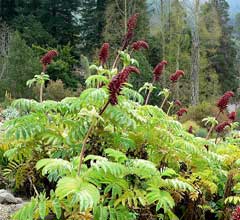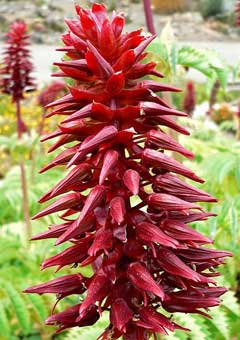 |
|
http://commons.wikimedia.org/wiki/User:Stan_Shebs |
 |
| http://commons.wikimedia.org/wiki/User:Stan_Shebs |
Translate this page:
Summary
Physical Characteristics

 Melianthus major is an evergreen Shrub growing to 3 m (9ft) by 3 m (9ft) at a medium rate.
Melianthus major is an evergreen Shrub growing to 3 m (9ft) by 3 m (9ft) at a medium rate.
See above for USDA hardiness. It is hardy to UK zone 8. It is in leaf all year, in flower from July to August. The species is hermaphrodite (has both male and female organs) and is pollinated by Bees.
Suitable for: light (sandy), medium (loamy) and heavy (clay) soils, prefers well-drained soil and can grow in nutritionally poor soil. Suitable pH: mildly acid, neutral and basic (mildly alkaline) soils. It can grow in semi-shade (light woodland) or no shade. It prefers moist soil. The plant can tolerates strong winds but not maritime exposure.
UK Hardiness Map
US Hardiness Map
Synonyms
Plant Habitats
Woodland Garden Sunny Edge; Dappled Shade; Cultivated Beds; South Wall. By. West Wall. By.
Edible Uses
Edible Parts: Nectar
Edible Uses: Sweetener
The honey-like nectar from the flowers is eaten[2, 105, 177, 183]. Deliciously sweet, a tiny bit seems to go a long way - which is very useful since the plant does not produce that much in the British climate[K].
References More on Edible Uses
Medicinal Uses
Plants For A Future can not take any responsibility for any adverse effects from the use of plants. Always seek advice from a professional before using a plant medicinally.
Antidote Emetic Vulnerary
Vulnerary[46, 61]. The root is poisonous and emetic, but is used as a remedy against snake bites[240].
References More on Medicinal Uses
The Bookshop: Edible Plant Books
Our Latest books on Perennial Plants For Food Forests and Permaculture Gardens in paperback or digital formats.

Edible Tropical Plants
Food Forest Plants for Hotter Conditions: 250+ Plants For Tropical Food Forests & Permaculture Gardens.
More

Edible Temperate Plants
Plants for Your Food Forest: 500 Plants for Temperate Food Forests & Permaculture Gardens.
More

More Books
PFAF have eight books available in paperback and digital formats. Browse the shop for more information.
Shop Now
Other Uses
References More on Other Uses
Cultivation details
Requires a well-drained moisture retentive soil in full sun or light shade[200]. Prefers a rich loamy soil[1]. Fertile soils give good foliage effects but the plant flowers better on a poor soil[200]. A very ornamental plant it is only hardy in the milder areas of Britain[1], flowering freely in Cornwall[59]. In colder parts of the country it can be grown as a herbaceous perennial, dying down in winter but regrowing from the base in the spring[166, 200]. In these areas the rootstock must be well mulched[200]. The top growth is possibly hardy for short periods down to -10°c, whilst the rootstock is possibly hardy to -15°c if it is well mulched[187]. The flowers have a honey-like scent[245]. The bruised leaves have a strong aroma somewhat like peanut butter[K]. Plants are often used in sub-tropical bedding schemes[1]. Members of this genus are rarely if ever troubled by browsing deer[233].
References Carbon Farming Information and Carbon Sequestration Information
Temperature Converter
Type a value in the Celsius field to convert the value to Fahrenheit:
Fahrenheit:
The PFAF Bookshop
Plants For A Future have a number of books available in paperback and digital form. Book titles include Edible Plants, Edible Perennials, Edible Trees,Edible Shrubs, Woodland Gardening, and Temperate Food Forest Plants. Our new book is Food Forest Plants For Hotter Conditions (Tropical and Sub-Tropical).
Shop Now
Plant Propagation
Seed - sow spring in a warm greenhouse[188]. Prick out the seedlings into individual pots when they are large enough to handle. Grow on the seedlings for at least their first winter in a greenhouse and plant out in late spring or early summer after the last expected frosts[K]. Cuttings of greenwood stem tips in a frame in summer[200]. Suckers in spring[200]. They can be planted out immediately or potted up and kept in a frame for their first winter.
Other Names
If available other names are mentioned here
Native Range
AFRICA: South Africa (Cape Province)
Weed Potential
Right plant wrong place. We are currently updating this section.
Please note that a plant may be invasive in one area but may not in your area so it's worth checking.
Conservation Status
IUCN Red List of Threatened Plants Status :

Growth: S = slow M = medium F = fast. Soil: L = light (sandy) M = medium H = heavy (clay). pH: A = acid N = neutral B = basic (alkaline). Shade: F = full shade S = semi-shade N = no shade. Moisture: D = dry M = Moist We = wet Wa = water.
Now available:
Food Forest Plants for Mediterranean Conditions
350+ Perennial Plants For Mediterranean and Drier Food Forests and Permaculture Gardens.
[Paperback and eBook]
This is the third in Plants For A Future's series of plant guides for food forests tailored to
specific climate zones. Following volumes on temperate and tropical ecosystems, this book focuses
on species suited to Mediterranean conditions—regions with hot, dry summers and cool, wet winters,
often facing the added challenge of climate change.
Read More
Expert comment
Author
L.
Botanical References
73200
Links / References
For a list of references used on this page please go here
Readers comment